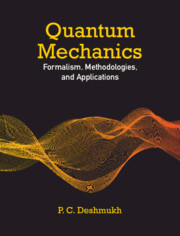Book contents
- Frontmatter
- Dedication
- Contents
- List of Figures
- Foreword
- Preface
- 1 Description of a Physical System
- 2 Path Integral Formulation of Quantum Mechanics
- 3 Probability Tangles and Eigenstates of One-dimensional Potentials
- 4 Angular Momentum
- 5 The Non-relativistic Hydrogen Atom
- 6 Approximation Methods
- 7 The Relativistic Hydrogen Atom
- 8 Quantum Mechanics of Spectral Transitions
- 9 The Many-Electron Atom
- 10 Quantum Collisions
- 11 Introduction to Quantum Information and Quantum Computing
- Appendix A Symmetry of the Hamiltonian
- Appendix B Schrödinger, Heisenberg, and Dirac “Pictures” of Quantum Dynamics
- Appendix C Spherical Harmonics
- Appendix D Occupation Number Formalism Second Quantization
- Appendix E Electron Structure Studies with Qubits
- Index
4 - Angular Momentum
Published online by Cambridge University Press: 14 September 2023
- Frontmatter
- Dedication
- Contents
- List of Figures
- Foreword
- Preface
- 1 Description of a Physical System
- 2 Path Integral Formulation of Quantum Mechanics
- 3 Probability Tangles and Eigenstates of One-dimensional Potentials
- 4 Angular Momentum
- 5 The Non-relativistic Hydrogen Atom
- 6 Approximation Methods
- 7 The Relativistic Hydrogen Atom
- 8 Quantum Mechanics of Spectral Transitions
- 9 The Many-Electron Atom
- 10 Quantum Collisions
- 11 Introduction to Quantum Information and Quantum Computing
- Appendix A Symmetry of the Hamiltonian
- Appendix B Schrödinger, Heisenberg, and Dirac “Pictures” of Quantum Dynamics
- Appendix C Spherical Harmonics
- Appendix D Occupation Number Formalism Second Quantization
- Appendix E Electron Structure Studies with Qubits
- Index
Summary
In Chapter 1 we discussed the role of linear momentum as the generator of translational displacement in homogeneous space. Likewise, it is instructive to explore the role of angular momentum as the generator of rotational displacements in isotropic space. Not surprisingly, analogies drawn from classical physics are not adequate to describe physical particles and fields. One must therefore redefine angular momentum to describe appropriately the physical properties in nature by quantum mechanics.
4.1 Definition and Properties of Angular Momentum
Kepler orbits of planets around the sun signify our intuitive understanding of angular momentum of an object about a point (Fig. 4.1). It interprets angular momentum as moment of the momentum, expressed as the cross product of the position vector of an object with its instantaneous linear momentum. We recognize it to represent a physical quantity that is conserved in isotropic space. The classical definition of angular momentum is however not sustainable, and not just because simultaneous measurements of position and momentum are incompatible. Physical properties of particles and fields have properties that have no classical analogues. Quantum mechanics acknowledges the intrinsic incompatibility in observations of some physical properties and provides a defensible alternative theory to describe nature. We shall therefore be able to persist with the classical interpretation of angular momentum as the generator of rotation in isotropic space only up to a certain point of our analysis; beyond it, we shall require a worthier mathematical model that is robust enough to describe nature acceptably.
We consider an object having an arbitrary shape and subject it to a rotation about an axis through it, such as the one schematically shown in Fig. 4.2a. On turning it through an infinitesimal angle, the shape transforms to. We denote the rotation by an operator and express this operation as
With reference to a Cartesian coordinate system, a rotation relocates a point whose position vector is to (Fig. 4.2b):
Equation 4.1 tells us that the function has the same value at the new orientation as the function, i.e., as, R being the operator corresponding to the said rotation. We shall refer to such a description of transformation of the function as active. In passive description, an equivalent inverse operation on the coordinate system is employed (Fig. 4.2c), leaving the function itself unchanged. The active and the passive descriptions are equivalent.
- Type
- Chapter
- Information
- Quantum MechanicsFormalism, Methodologies, and Applications, pp. 147 - 195Publisher: Cambridge University PressPrint publication year: 2024



